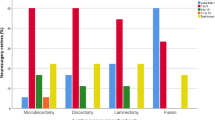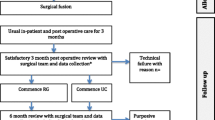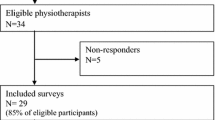Abstract
This study aimed to identify current NHS physiotherapy practice following first time lumbar discectomy in the United Kingdom (UK) in order to inform future research priorities and design. Descriptive survey methodology was utilised employing a postal questionnaire. A total population sample was identified and questionnaires were posted to 87 NHS physiotherapy departments throughout the UK. Participants were senior physiotherapists working with spinal surgery patients. In the inpatient phase, the majority of patients receive physiotherapy. Management focused on mobility and education to facilitate early discharge with most patients being given exercises. However, there was a wide variation in the actual exercises prescribed. There was more variation in the provision of outpatient physiotherapy treatment. Not all patients have access to physiotherapy treatment post discharge in the UK and when treatment was available the content and amount was variable. There is evidence to support rehabilitation classes to assist early improvements in function and return to work but such classes are only available in around half of the centres involved in this study. Regarding the content of exercise classes and individual treatment sessions, a wide range of clinical practice was evident. This study raises many research questions and highlights the need for future research to optimise patient rehabilitation following first time lumbar discectomy.



Similar content being viewed by others
References
Bandolier (1995) Back pain and back pain guidelines; 19 September (Index). http://www.jr.ox.ac.uk/bandolier/band19/b19html
Breig A (1978) Adverse mechanical tension in the nervous system. Almqvist and Wiksell, Stockholm
Brennan G, Shultz B, Hood R, Zahniser J, Johnson S, Gerber A (1994) The effects of aerobic exercise after lumbar microdiscectomy. Spine 19:735–739
Butler D (1991) Mobilisation of the nervous system. Churchill Livingstone, London
Carragee E, Helms E, O’Sullivan G (1996) Are post-operative activity restrictions necessary after posterior lumbar discectomy? Spine 21:1893–1897
Carragee E, Han M, Yang B, Kim D, Kraemer H, Billys J (1999) Activity restrictions after posterior lumbar discectomy. Spine 24:2346–2351
Culav E, Clark C, Merrilees M (1999) Connective tissues: matrix composition and its relevance to physical therapy. Phys Ther 79:308–319
Danielsen J, Johnsen R, Kibsgaard S, Hellevik E (2000) Early aggressive exercise for post-operative rehabilitation after discectomy. Spine 25:1015–1020
Dolan P, Greenfield, Nelson R, Nelson W (2000) Can early exercise therapy improve the outcome of microdiscectomy? Spine 25:1523–1532
Donceel P, Du Bois M (1998) Fitness for work after surgery for lumbar disc herniation; a retrospective study. Eur Spine J 7:29–35
Donceel P, Du Bois M (1999) Predictors for work incapacity continuing after disc surgery. Scand J Work Health Environ 25:264–271
Donceel P, Du Bois M, Lahaye D (1999) Return to work after surgery for lumbar disc herniation. Spine 24:872–876
Gejo R, Matsui H, Kawaguchi Y, Ishihara H, Tsuji H (1999) Serial changes in trunk muscle performance after posterior lumber surgery. Spine 24:1023–1028
Gejo R, Kawaguchi Y, Kondoh T, Tabuchi E, Matsui H, Torii K, Ono T, Kimura T (2000) Magnetic resonance imaging and histological evidence of post-operative back muscle injury in rats. Spine 25:941–946
Gibson JNA, Grant IC, Waddell G (2003) Surgery for lumbar disc prolapse. In: The cochrane library, Issue 2. Update software, Oxford
Hides JA, Stokes MJ, Saide M, Jull GA, Cooper DH (1994) Evidence of lumbar multifidus muscle wasting ipsilateral to symptoms in patients with acute/subacute low back pain. Spine 19:165–172
Hides JA, Richardson CA, Jull GW (1996) Multifidus muscle recovery is not automatic after resolution of acute, first episode low back pain. Spine 21:2763–2769
Hides JA, Jull GA, Richardson CA (2002) Long-term effects of specific stabilization exercises for first episode low back pain. Spine 26:E243–E248
Hodges PW, Richardson CA (1996) Inefficient muscular stabilization of the lumbar spine associated with low back pain: a motor control evaluation of transversus abdominis. Spine 21:2640–2650
Kjellby-Wendt G, Styf J (1998) Early active training after lumbar discectomy. Spine 23:2345–2351
Linton S (2000) A review of psychological risk factors in back and neck pain. Spine 25:1148–1156
Manniche C, Skall H, Braendolt L, Christensen B, Christophersen L, Ellegaard B et al (1993) Clinical trial of post-operative dynamic back exercises after first lumbar discectomy. Spine 18:92–97
Nachemson AL (1975) Towards a better understanding of low-back pain: a review of the mechanics of the lumbar disc. Rheumatol Rehabil 14:129–143
Oppenheim AN (2001) Questionnaire design, interviewing and attitude measurement. New edn. Continuum, pp 103–5
Ostelo RWJG, de Vet HCW, Waddell G, Kerckhoffs MR, Leffers P, van Tulder MW (2003) Rehabilitation after lumbar disc surgery. In: The cochrane library, Issue 2. Update software, Oxford
O’Sullivan PB, Twomey L, Allison GT (1998) Altered abdominal muscle recruitment in patients with chronic back pain following specific exercise intervention. J Ortho Sports Phys Ther 27:114–124
Provenzano P, Martinex D, Grindeland R, Dwyer K, Turner J, Vailas A, Vanderby R (2003) Hindlimb unloading alters ligament healing. J Appl Physiol 94:314–324
Rantanen J, Hurme M, Falck B (1993) The lumbar multifidus muscle 5 years after surgery for a lumbar intervertebral disc herniation. Spine 18:568–574
Robson C (2002) Real world research. 2nd edn. Blackwell, Oxford
Scrimshaw S, Maher C (2001) Randomised controlled trial of neural mobilisation after spinal surgery. Spine 26:2647–2642
Twomey L, Taylor J (2000) Lumbar posture, movement, and mechanics. In: Twomey L, Taylor J (Eds) Physical therapy of the low back. 3rd edn. Churchill Livingstone. New York, pp 81–83
Author information
Authors and Affiliations
Corresponding author
Rights and permissions
About this article
Cite this article
Williamson, E., White, L. & Rushton, A. A survey of post-operative management for patients following first time lumbar discectomy. Eur Spine J 16, 795–802 (2007). https://doi.org/10.1007/s00586-006-0207-8
Received:
Revised:
Accepted:
Published:
Issue Date:
DOI: https://doi.org/10.1007/s00586-006-0207-8




